Last month, on November 23rd, my girls went to Famosa Slough because I wanted to check out and see how the plants were doing. I knew that the toyon and buckwheat were in bloom, but what other surprises were we in for? I can tell you upfront that I saw my first California boxthorn bush! Have you ever seen one in the wild?
So today, I wish to keep things casual, seeing that I have written more in-depth about almost all of these plants.
Please see the links down below if you would like further information.
Table of Contents
A Few Famosa Slough Facts

First and foremost, the Famosa Slough is a living wetland preserve and a Marine Protected Area, meaning nothing is to be touched or taken. It survives as a wetland by the tidal flow from the culvert pipes that connect it to the San Diego River Channel.
It consists of two sections: the Northern Channel, 12 acres, and the southern portion, 25 acres of mixed wetlands. The more south you go, the less saline the water.
I have been here four times and have written about Famosa Slough before, only concentrating on the southern section. Well, today, we explored both.
North Channel of Famosa Slough

The North section connects to the San Diego River Channel north, with the southern portion just across the street.
The small trail over here runs parallel to a few apartment complexes. Also, there might be someone sleeping in the larger bushes.
Pay attention to your surroundings.
South Area- Famosa Slough
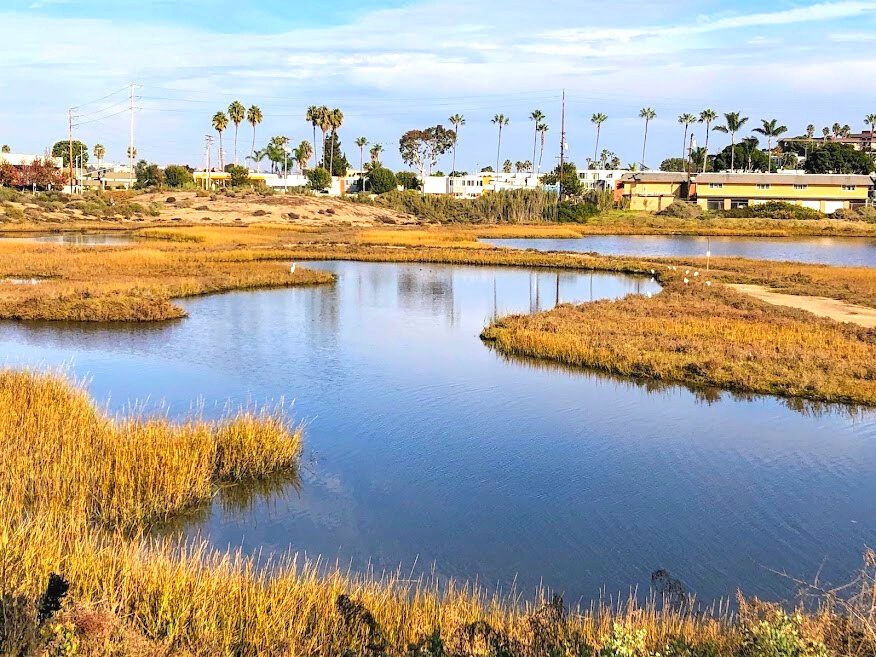
Today was the first time I parked on West Point Loma Blvd and started our adventure in the Northern Channel, then crossed the street and started at a new entrance point.
I had no idea that there was a bench over here!
There are five benches scattered around Famosa Slough.
As we continued to follow the trail due south, I was pleasantly surprised at how much restoration work has been in progress since the last time we visited here in 2018.
#Click on any photo to see a larger version
So let’s now look at what we witnessed at the Famosa Slough wetlands preserve. Let’s now go and have a look at what we were able to identify within this wetlands preserve.
I want to note that I will share each plant under their Family names. For me, this helps my brain.
Ok, let’s go!
Family Amaranthaceae
California Saltbush- Atriplex lentiformis
Other Names– white thistle, quail bush, lenscale, big saltbush
Subfamily- Chenopodioideae (Goosefoot)
Interesting Information–
- widely spreading found in saline and alkaline environments
- a popular plant for restoration projects
- flowering from July to October
Family Anacardioideae
Lemonade Berry Bush- Rhus integrifolia
Other Names– lemonadeberry, lemonade sumac
Interesting Information–
- round and leathery leaves
- flowering from February to May
- native to the South Coast regions of Southern California- from Santa Barbara to northern Baja California
- you can soak the berries to make a refreshing drink that tastes like…wait for it…lemonade!
Laural sumac- Malosma laurina
Other Names– California sumac, taco plant
Interesting Information–
- North-facing with taco-shaped leaves
- leaf veins, stems, and small twigs are reddish
- flowering time from June to July
- It was used by the early settlers as a sentinel plant to indicate where citrus should be grown. This is because laurel sumac can not tolerate freezing weather.
Family Asteraceae
Mule Fat- Baccharis salicifolia
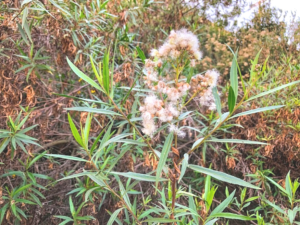
Other Names– seep-willow, mulefat
Interesting Information-
- male flowers have little red spots, while female flowers are all white
- flowering time from February to December
- it received the name ‘Mule-fat’ due to mules becoming bloated after eating the plant
- early colonizer, which needs a water source nearby
San Diego Sunflower- Bahiopsis laciniata
Other Names- San Diego County sunflower, torn-leaf goldeneye, San Diego Viguiera, Bush Sunflower
Interesting Information-
- distributed as far north as Ventura County
- found in chaparral and coastal sage scrub communities
- flowering time from February to August
California Sunflower- Encelia californica
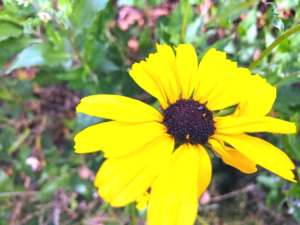
Other Names- California brittlebush, California Encelia, bush sunflower
Interesting Information-
- flowering time from February to June
- native from Santa Maria (Central Coast) down to San Diego
#– Do you notice the difference between the San Diego sunflower and the California Sunflower? A great way to remember is that the bush sunflower has a darker center.
Coyote Brush- Baccharis pilularis
Other Names- coyote bush, chaparral broom
Interesting Information-
- one of the first colonizers after a fire, as the root crown, can resprout
- Baccharis is the only genus in the family Asteraceae that is dioecious- separate male and female plants
- produces creme-colored flowers, with the male flowers being smaller and yellower; compared to the female flowers, which have a fluffier appearance toward the end of flowering
- flowering from August to December
Coastal Goldenbush- Isocoma menziesii
Other Names- Menzie’s goldenbush, Goldenbush
Interesting Information-
- remains green all year round
- upper leaves are less toothed
- flowering from April to December
- native to California and Baja California and grows in coastal and inland scrub, particularly in sandy soils
California Sagebrush- Artemisia californica
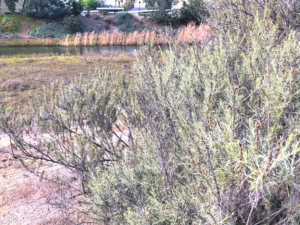
Other Names- Old Man, coastal sagebrush
Interesting Information-
- dominant plant in the coast sagebrush community, as well as an essential member of some chaparral and dry foothills habitats
- not a true sage but has sage-like smelling terpene chemicals that inhibits the growth of other plant species underneath and around the plant
- flowering time from August to December
Family Cactaceae
Coastal Prickly Pear Cactus- Opuntia littoralis
Other Names- nopal, Western prickly pear
Interesting Information-
- was an important plant species for grazing cattle during dry spells in the early twentieth century
- the internal tissues of the pads contain water
- edible fruit called tuna, which tastes similar to watermelon
- flowering time from May to June
Family Frankeniceae
Alkali Heath- Frankenia salina
Other Names- alkali seaheath, alkali-heath, yerba reuma
Interesting Information-
- secretes salt on leaves
- flowers April to October
- the Spanish name, yerba reuma, loosely is translated to mean herb for colds
Family Juncaceae
Spiny Rush- Juncus acutus
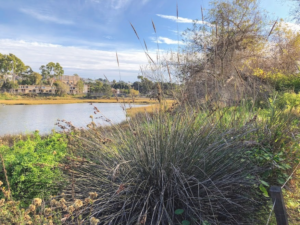
Other Names- sharp rush, sharp-leaved rush, southwestern spiny rush, spike rush, Leopold’s rush
Interesting Information-
- In most cases, the spiny rush is found as a narrow band around the uppermost fringe of the salt marsh, where the soil salinity is reduced.
- The genus name, Juncus, is believed to be derived from the Latin word jungere, which means-“to join or bind” The stems and leaves were used for weaving or binding.
- leaf tips are hard and sharp
- flowering time from May to August
Family Lamiaceae
Black Sage- Salvia mellifera
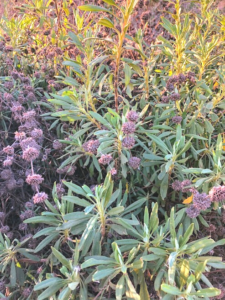
Other Names- Jade carpet, honey sage
Interesting Information-
- a frequent co-dominant in the coastal sage scrub community
- lavender flowers with square stems
- flowering time from April to July
- The Latin species name- mellifera means honey-bearing. Honey from black sage is believed to be the best, with many medicinal properties.
Family Polygonaceae
California Buckwheat- Eriogonum fasciculatum
Other Names- flat-topped buckwheat, Antelope sage, sulfur flower, skeleton weed, wild buckwheat, eastern Mojave buckwheat, Colita de Raton
Interesting Information-
- dominate species in the coastal sage scrub community and scattered in the chaparral; especially in disturbed areas
- significant in the butterfly and bee communities and is the predominant source of honey in California
- leaves clustered at nodes
- flowering time from March to November
Family Solanaceae
California Boxthorn Bush- Lycium californicum
Other Names- Box thorn, California wolfberry, California desert thorn
Interesting Information-
- succulent shrub found in the coastal bluffs in southwestern California and northern Baja California that is in the tobacco and potato family
- fleshy leaves- flowers usually have four petals
- flowering time from March to July
- California Rare Plant Rank of 4.2 due to limited distribution in California because of development, foot traffic, and trail maintenance
Family Rosaceae
Toyon- Heteromeles arbutifolia
Other Names- California holly, Christmas berry
Interesting Information-
- found in chaparral and coastal sage scrub; often in canyons and north-facing slopes
- after a fire, toyon resprouts vigorously from the root crown system
- both the leaves and the berries have cyanic compounds in them, which reduces herbivory
- berries usually red in December
- flowering time from June to July
Other Helpful Posts–
- Slough What? Discovering Famosa Slough
- Southern California Native Plants/ Native Uses
- Plants at the Beach- San Onofre
- Best San Diego Birding Hotspots
Resources-

I have always had a deep-seated passion for the Ocean Environment which ultimately led me to receive a degree in Marine Biology. Living in the San Diego area for over 30 years, I have extensively explored the 70 miles of San Diego’s coastline, and I am here to share! Please use my website to your advantage and have a look around at all the wonders that the beaches of San Diego can offer you!
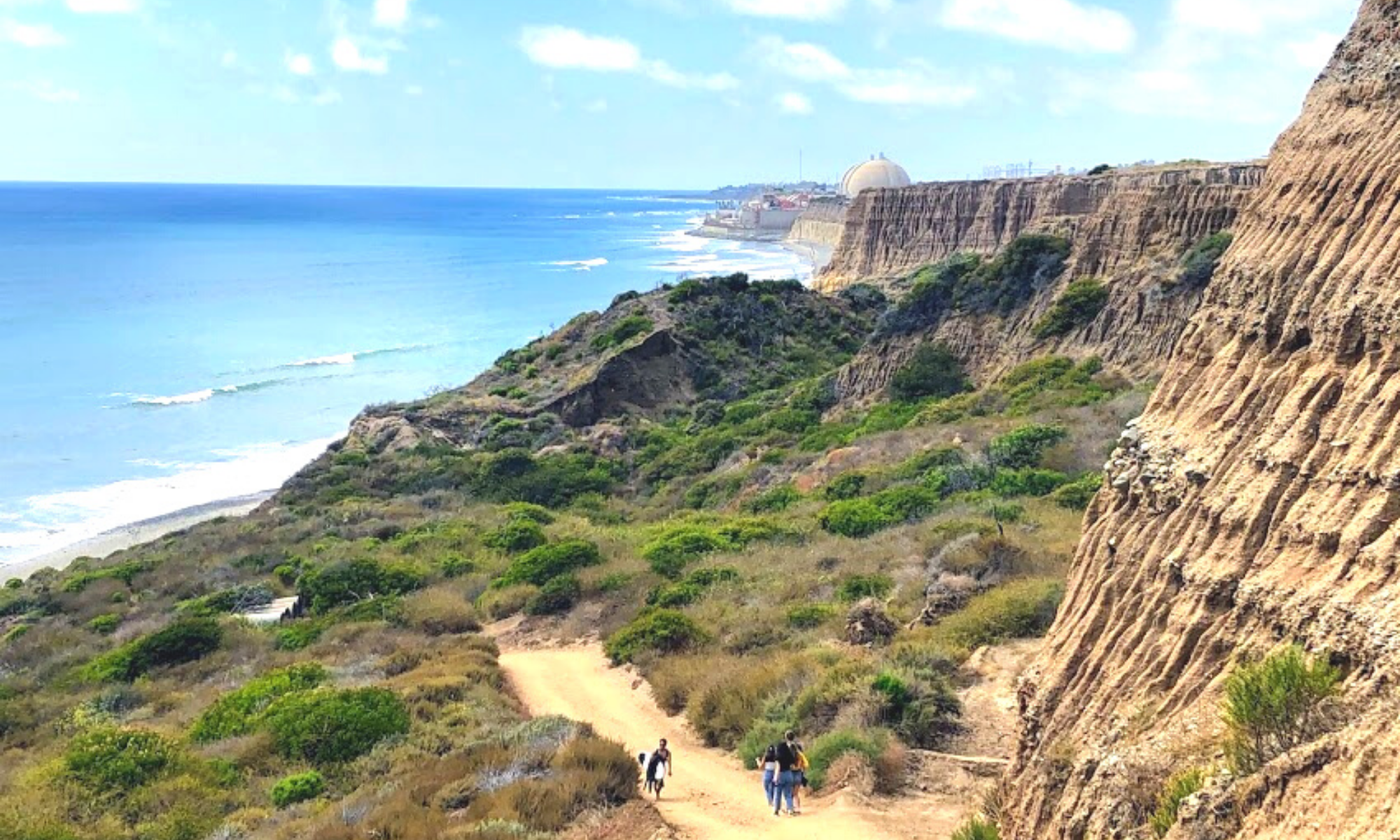
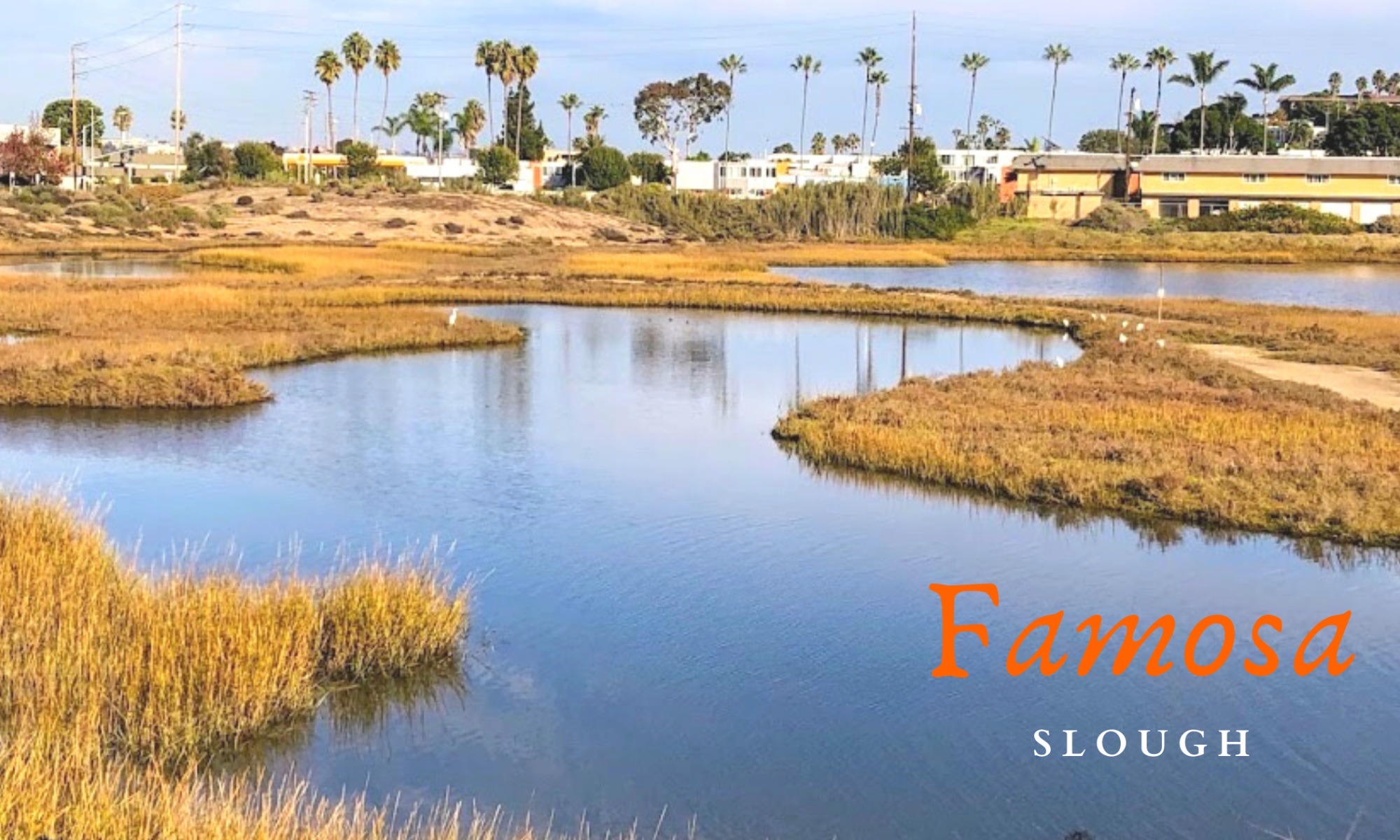

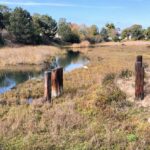
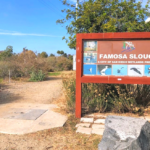
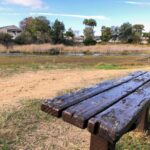
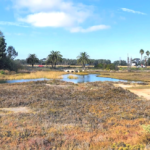
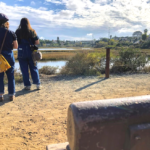
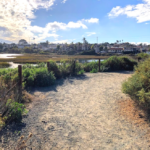
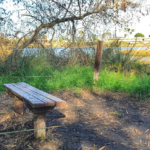
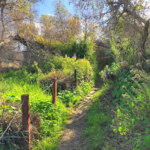
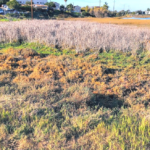
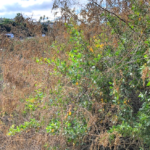
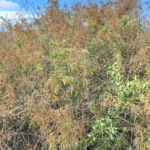
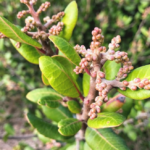
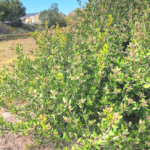
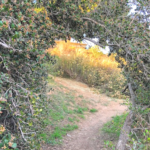
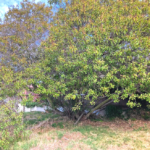
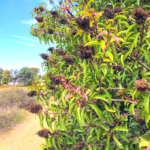
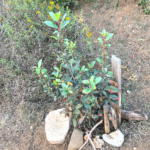
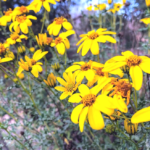
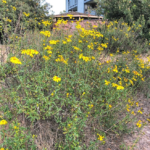
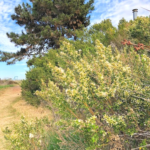
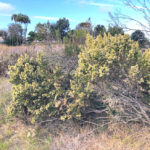
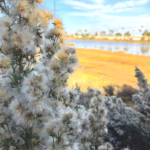

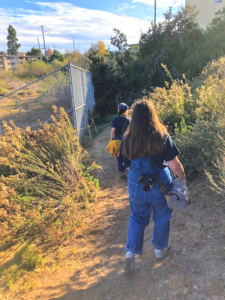

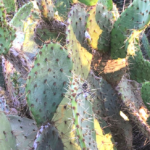
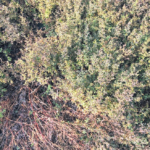
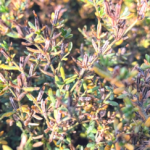
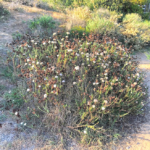
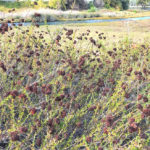
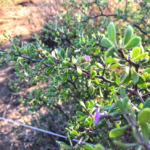
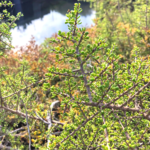
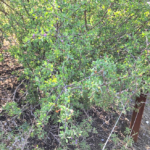
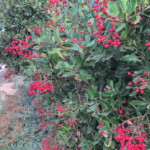
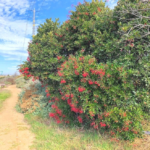
Hello Colleen,
Thank you for distributing the information about Famosa Slough and its native vegetation. I think that there are actually 10 benches at different viewpoints around Famosa Slough.
I think of the Slough as having 3 areas, the channel (North of West Point Loma Boulevard), the main body of the Slough (South of WPL Boulevard), and the 2 acre stormwater treatment ponds (at the southern tip of the Slough).
The Slough is normally dominated by ocean water and is subject to almost the full range of ocean tides. Stormwater from a 300 acre watershed drains into the Slough at 19 places. The rainwater pushes much of the salt water out for a while during after each major rain event.
Besides the native plants that you mentioned, Famosa Slough is also a good place for watching birds. Birds of 241 species have been sighted there. Currently a lot of migratory shorebirds, ducks and wading birds are visible and very active.
Hi Jim! Thank you so much for taking the time to comment. I appreciate you stating the number of benches, as I failed to count why we walked around. I have been coming here since 2018 and can tell how much restoration work has been done here. So thank you! My girls and I absolutely love coming here.